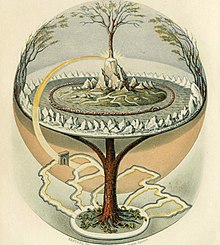| Origin
|
associated deity/spirits
|
| Aboriginal mythology
|
Baiame (Kamilaroi), Eingana
|
| Akkadian mythology
|
Allu, Anu, Anunnaku, Ereshkigal, Etemmu, Gallu, Humbaba, Mamitu, Nergal, Utnapishtim
|
| Albanian mythology
|
E Bukura e Dheut
|
| Turko-Mongol
|
Erlik
|
| Armenian mythology
|
Spandaramet
|
| Aztec mythology
|
Mictlantecuhtli & Mictecacihuatl (advocations: Chalmecacihualt, Chalmecatl)
|
| Babylonian mythology
|
Erra, Nergal, Ninlil, Sursunabu, Ur-shanabi, Utnapishtim
|
| Balinese mythology
|
Batara Kala, Setesuyara
|
| Bon mythology
|
gNyan
|
| Buddhism
|
King Yama
|
| Canaanite mythology
|
Mot, Arsay
|
| Celtic mythology
|
Aed, Arawn, Cwn Annwn, Donn, Gwyn ap Nudd, Manannán mac Lir, Pwyll, Nemain, The Morrigan, Taranis (sometimes in popular culture).
|
| Chinese folk religion
|
Yanluo Wang, Heibai Wuchang, Ox-Head and Horse-Face, Meng Po, Zhong Kui
|
| Christianity
|
Satan, Lucifer, Beelzebub, Belial
|
| Egyptian mythology
|
Aken, Aker (strictly only the gatekeeper), Am-heh, Amunet, Ammit, Andjety, Anubis, Apep, Apis, Astennu, Ha, Imiut (if the Imiut was ever considered a god), Isis, Mehen, Naunet, Nehebkau, Nephthys, Nun, Nut, Osiris, Ptah, Seker, Thoth, Wepwawet
|
| Elamite mythology
|
Jabru
|
| Estonian mythology
|
Vanapagan
|
| Etruscan mythology
|
Charun, Culsu, Februus, Mania, Mantus, Nethuns, Tuchulcha, Vanth
|
| Fijian mythology
|
Degei
|
| Finnish mythology
|
Kalma, Kipu-Tyttö, Kivutar, Lovitar, Surma, Tuonen akka, Tuonetar, Tuoni, Vammatar
|
| Greek mythology
|
Cerberus, Charon, Hades, Pluto, Keres, Persephone, Thánatos, Eris, Hermes, Hera
|
| Georgian mythology
|
sasuleti
|
| Germanic religion
|
Garmr, Hel, Rán, Níðhögg
|
| Haida mythology
|
Ta'xet, Tia
|
| Hattian mythology, Hittite mythology
|
Lelwani
|
| Hinduism
|
Yama
|
| Hopi mythology
|
Maasaw
|
| Hungarian mythology
|
Ördög
|
| Ibo mythology
|
Ala
|
| Incan mythology
|
Supay, Vichama
|
| Indonesian mythology (ancient Javananese, Sundanese and Balinese)
|
Batara Kala guardian for sinners souls' underworld, Dewi Sri guardess for the righteous souls' underworld
|
| Islam
|
Maalik (Guardian)
|
| Inuit mythology
|
Pana, Sedna
|
| Japanese mythology
|
Izanami-no-Mikoto, Jikininki, Shikome, Shiryō, Susanoo-no-Mikoto
|
| Judaism
|
Satan, Malach HaMavet ("Angel of Death") (both are associated with Samael), Malachei Habala ("Sabotage Angels"), Dumah
|
| Kassite mythology
|
Dur
|
| Khmer mythology
|
Preas Eyssaur
|
| Latvian mythology
|
Veļi, Veļu māte, Zemes māte
|
| Lithuanian mythology
|
Velnias, Velinas
|
| Levantine mythology
|
Mot, Arsay
|
| Lunda mythology
|
Kalunga
|
| Mandaean mythology
|
Ruha, Ur, Krun, Gaf, Qin, Zahreil, Lilith, Niuli, Saṭani, Latabi, Nalai, Gadulta, Anathan, Giu, Shdum, Zartai-Zartanai, Hag, Mag
|
| Maori mythology
|
Hina, Hine-nui-te-Po, Kewa, Mahiuki, Rohe, Whiro
|
| Maya mythology
|
Ah Puch (Lords: Hun-Came & Vucub-Came)
|
| Melanesian mythology
|
(includes Fijian mythology) Degei, Ratumaibulu, Samulayo
|
| Narragansett mythology
|
Chepi
|
| Navaho mythology
|
Estsanatlehi
|
| Niquiran mythology
|
Mictanteot
|
| Ob-Ugrian mythology
|
Heini-iki
|
| Orokolo mythology
|
Kiavari
|
| Persian mythology
|
Angra Mainyu, Azhi Dahaka, Div (mythology)
|
| Philippine mythology
|
Magwayen/Maguayen, Sidapa
|
| Phoenician mythology
|
Horon
|
| Phrygian mythology
|
Men
|
| Polynesian mythology
|
Hikuleo, Hina, Hine-nui-te-Po, Kanaloa, Kiho-tumu, Makea Tutara, Mahuika, Mahu-ika, Marama, Mauri, Merau, Milu, Miru, Rimu, Rohe, Whiro
|
| Prussian mythology
|
Picullus
|
| Pueblo mythology
|
Iyatiku
|
| Roma (Gypsy) mythology
|
Beng
|
| Roman mythology
|
Cerberus, Dea Tacita, Dis Pater, Egestes, Fames, Inferi Di, Larenta, Letum, Libitina, Mors, Orcus, Pluto, Proserpina, Viduus
|
| Romanian mythology
|
Diavolu, Satana, Necuratu, Scaraoschi
|
| Russian mythology
|
Dyavol, Satanaya
|
| Saami mythology
|
Yambe-akka
|
| Salish mythology
|
Amotken
|
| Siberian mythology
|
Chebeldei, Kul
|
| Slavic mythology
|
Crnobog, Flins, Marzana, Nyia, Veles (god)
|
| Sumerian mythology
|
Edimmu, Ekimmu, Endukugga, Enmesharra, Ereshkigal, Gidim, Nintinugga, Irkalla, Kur, Namtar, Nergal, Bitu, Nindukugga, Ninlil, Urshanabi, Ziusudra
|
| Syrian mythology
|
Reshep
|
| Tamil mythology
|
Cur
|
| Thracian mythology
|
Heros
|
| Turkic mythology
|
Erlik
|
| Vietnamese mythology
|
Quảng Cung, Thập điện Diêm Vương, Hắc Bạch vô thường (couple of messengers lead the souls of the dead to the Âm phủ), Đầu Trâu Mặt Ngựa (has the same task as Hắc Bạch vô thường), Mạnh Bà (the maker of the oblivion soup called cháo lú by the Vietnamese)
|
| Wagawaga mythology
|
Tumudurere
|
| Welsh mythology
|
Annwfn or Annwn
|
| Yoruba mythology
|
Esu, Oya
|
| Yurak mythology
|
Nga
|
| Zuni mythology
|
Uhepono
|

